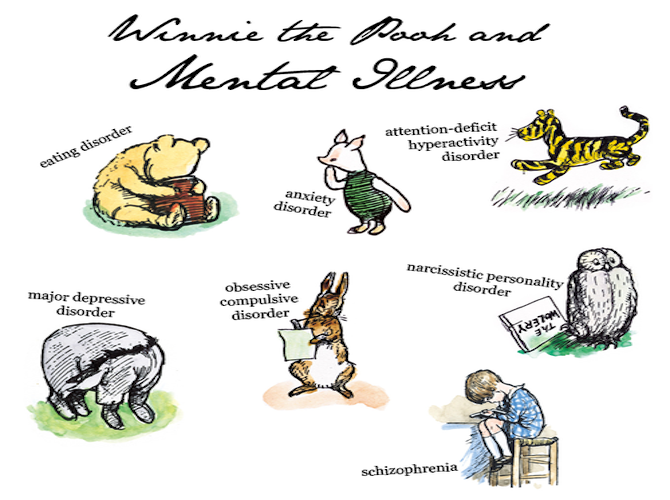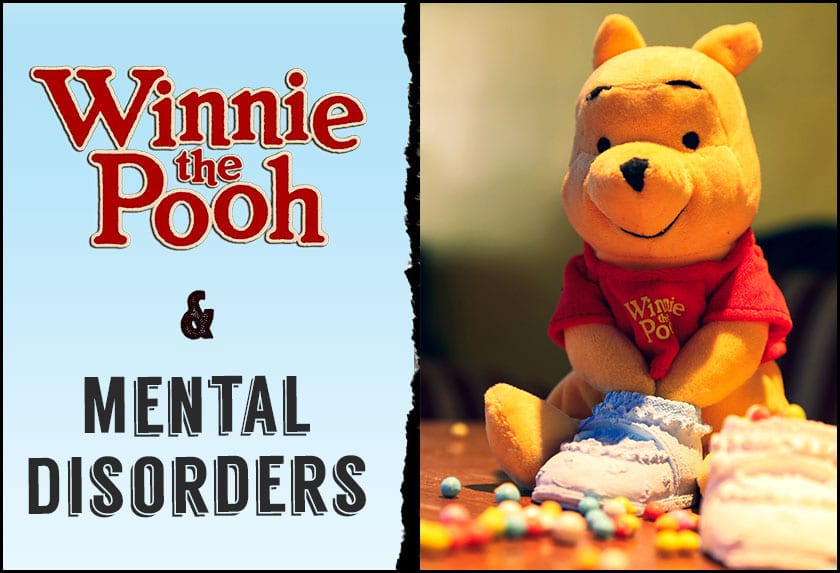Uncovering The A.A. Milne Universe: Winnie The Pooh & Psychological Disorders
Is it possible that the charming characters of the Hundred Acre Wood, those beloved figures from A.A. Milne's tales, might be more complex than meets the eye? The whimsical world of Winnie-the-Pooh, often seen as a comforting realm of childhood innocence, can surprisingly offer a lens through which to examine various psychological disorders and personality traits.
For decades, the endearing inhabitants of the Hundred Acre Wood have delighted readers of all ages. Their simple adventures, centered around friendship, honey, and the quiet joys of life, have become a staple of children's literature. However, a closer look at the personalities of Winnie the Pooh and his friends reveals a surprising depth, offering a fascinating perspective on human behavior. This is not to diminish the delight we take in these characters, but rather to explore how literature, even in its most seemingly innocent forms, can reflect and illuminate the complexities of the human experience. Consider the following analysis of each character, keeping in mind that these are literary interpretations, not definitive diagnoses. They are meant to spark thought and discussion, not to pathologize beloved fictional creations.
Let's delve into the psychological underpinnings of these beloved characters, exploring potential parallels to psychological disorders and traits. Remember, these are observations and interpretations; they are not meant to be clinical diagnoses. The goal is to enhance our understanding of the characters and, perhaps, ourselves.
| Character | Possible Psychological Traits/Disorders | Supporting Behaviors | Further Considerations |
|---|---|---|---|
| Winnie the Pooh |
|
| Pooh's insatiable appetite and tendency to become fixated on honey can be viewed through the lens of possible eating disorder behaviors. His forgetfulness and difficulty paying attention may align with characteristics observed in individuals with attention deficits. The link is not conclusive; it is an observation of behavior and how it could align. |
| Piglet |
|
| Piglets constant fear and avoidance behaviors align with characteristics often associated with anxiety disorders. His reactions to challenging situations, his shyness, and his desire to avoid social situations may be manifestations of this anxiety. |
| Eeyore |
|
| Eeyores consistently gloomy demeanor, his lack of enthusiasm, and his withdrawal from social interactions are characteristic of persistent depressive disorder. His negative view of himself and the world further support this analysis. |
| Tigger |
|
| Tiggers boundless energy, impulsivity, and tendency to become distracted are indicative of ADHD, particularly the hyperactive/impulsive type. His need for attention and excitement may also point to underlying emotional dysregulation. |
| Rabbit |
|
| Rabbit's need for control, his obsession with order and planning, and his perfectionism may be suggestive of OCPD. His anxiety and stress when his order is disrupted also align with this interpretation. |
| Owl |
|
| Owl's tendency to be seen as the intellectual of the group and is prone to using long, complicated words. He also displays himself as the "expert". |
These observations open a window into the understanding of common personality traits and behaviors. It is important to stress that applying diagnostic labels to fictional characters is not the point of such an exploration. Instead, it provides an engaging and approachable method to open discussions about the challenges of mental well-being.
Consider Winnie the Pooh, who is often characterized by his love for honey and his somewhat simple-minded nature. Pooh's impulsivity is evident in his tendency to become fixated on obtaining honey, often at the expense of his own well-being or the plans of his friends. His difficulty in concentrating and his tendency to wander off-task might be associated with ADHD. His desire for honey could also be a behavior seen in individuals with disordered eating habits. These are just literary interpretations and are in no way conclusive diagnoses.
Piglet, the timid friend of Pooh, is another character ripe for psychological analysis. Piglet's anxiety is a central aspect of his personality. His constant worry, his fear of the unknown, and his hesitancy to engage in new experiences all point to an underlying sense of nervousness. Piglet's anxiety is often triggered by social situations or perceived threats, which suggests the possibility of social anxiety or a generalized anxiety disorder.
Eeyore, with his consistently gloomy disposition, presents another intriguing case. Eeyore's pessimism, his lack of motivation, and his tendency to withdraw from social interactions are often associated with depressive disorders. His low self-esteem and pessimistic outlook are key to understanding his character.
Tigger, with his boundless energy and enthusiasm, offers a stark contrast to Eeyore. Tigger's hyperactivity, impulsivity, and constant need for excitement are suggestive of ADHD. Tigger's inability to sit still, his tendency to interrupt others, and his often-chaotic approach to life reflect a hyperactive/impulsive type of ADHD. His behavior, while entertaining, also highlights the challenges faced by individuals with ADHD, particularly when it comes to self-regulation and focus.
Rabbit, the planner of the group, reveals a completely different profile. Rabbit's obsession with rules, order, and control could point to traits of Obsessive-Compulsive Personality Disorder (OCPD). Rabbit's perfectionism, his need to have everything in its place, and his tendency to become stressed when plans are disrupted reflect his need for control. The contrast between Rabbit's need for order and Tigger's impulsivity also shows how different personalities can coexist within the same community.
Owl, the self-proclaimed wise member of the group, has certain behaviors that may show potential narcissistic traits. His tendency to share his knowledge and long words with others can be a sign of self-importance. He sees himself above the rest of the Hundred Acre Wood members and tries to show that he is always superior.
The Hundred Acre Wood, in its seemingly simple narratives, serves as a microcosm of human experience. The relationships between Pooh and his friends reflect the complexities of social interactions, the challenges of managing emotions, and the importance of support systems. The characters' interactions can also be viewed as lessons in empathy, acceptance, and understanding. They teach us to be compassionate toward each other, as well as the value of friendship.
The enduring appeal of Winnie-the-Pooh lies in the authenticity of its characters and the universal themes it explores. By examining the psychological aspects of these beloved figures, we can gain a deeper appreciation for the complexities of human behavior and the importance of mental health.
The analysis of the Hundred Acre Wood characters does not intend to offer a diagnostic manual for individuals. Its goal is to provoke thought and discussion. There is great worth in the art of examining the behaviors that form the foundation of these endearing characters, regardless of their psychological complexity.
The psychological concepts discussed above are complex and deserve careful consideration. The insights into the world of Winnie-the-Pooh's Hundred Acre Wood can make this fascinating information easier to grasp. This study allows for better comprehension of the spectrum of individual behaviors.
These are the core lessons that the narrative of Winnie-the-Pooh teaches.
It's important to reiterate that these are literary interpretations, not clinical diagnoses. The purpose is to stimulate thought, encourage dialogue, and increase understanding of both the characters and the psychological ideas that shape their world. By approaching these beloved tales through a psychological lens, readers can appreciate the depth and enduring value of Winnie-the-Pooh.


